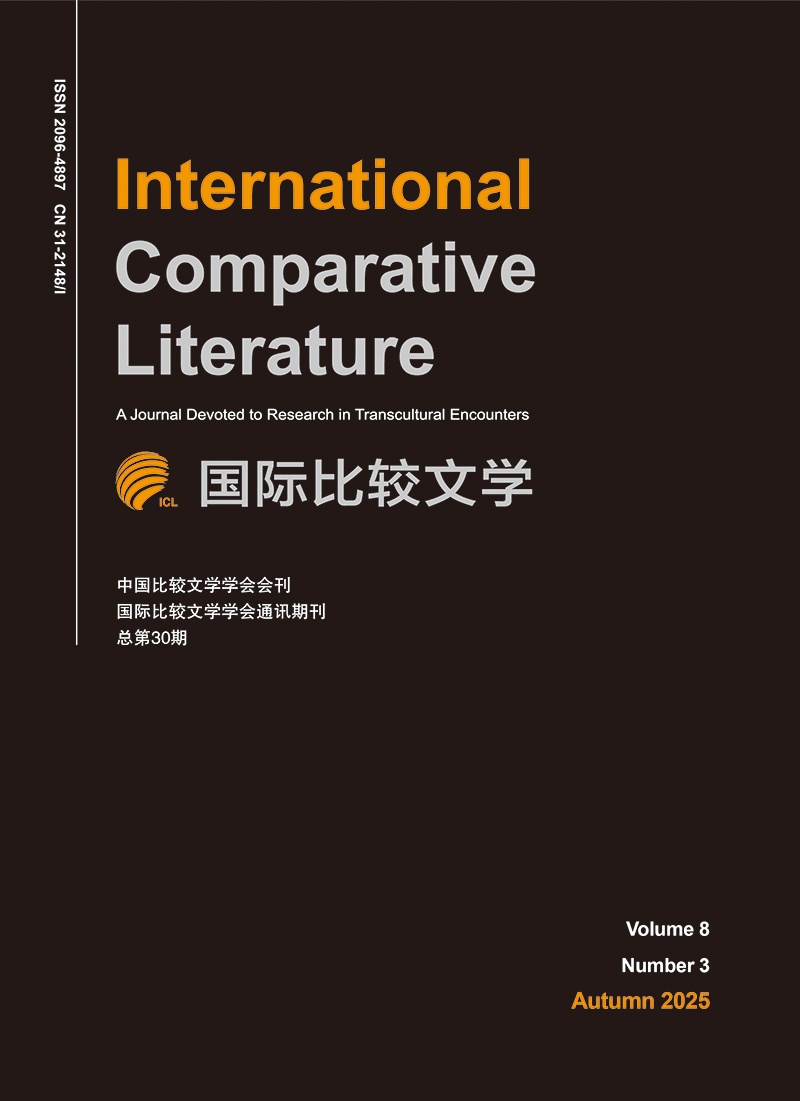音韵学的意外启示:参悟诗的意象化声调美
Serendipity: Seizing the Toned Picture of Poetry in the Light of Prosody
-
摘要: 世上真有什么方法能帮我们进一步发掘经典作品从而发现老路中的新路?在这方面,音韵学真能帮我们多少,让我们确确实实地搞明白那些不断地引起我们好奇、关注、却又不断地让我们疑惑不解的文学现象?比如,王安石的《泊船瓜洲》为何能如此诗意盎然、令人难以忘怀?根据本文的观点,真正使这首诗如此诗意盎然的,首先是这首诗的细致、单纯、情绪声调化了的语音结构。这首诗的"语音结构",不管如何未受重视,不仅"比词的句法更单纯、更本质",更能与心灵一脉相通。再按本文的分析,这首诗之所以会有如此特殊的魅力,归根结底,是因为诗中隐含着某种影响无时不在、却又常被视而不见的虚词。这种"渺小""隐身"的虚词就像一只"看不见的手",时刻为小诗增添无尽的诗意;它又像《奥义书》中最常用的比喻"水中之盐"一样,细致入微地调和着小诗的语音结构、味觉、口感,使之回味无穷,或者像"绘事后素" "大音希声" "大象无形"的说法所提示的那样,使小诗更出神入化。本文就此进一步探索是否能按同样的思路,以音韵学为指导,耳目一新地重新阅读经典作品,不单是汉语的经典作品,而且还包括其他非声调性语言中脍炙人口的经典作品,如罗伯特·弗洛斯特的《雪夜歇脚树林边》,并以此为契机,发掘重要的、却常被忽略的文化和文学作品的互相参照的诸多可能性。既然这种文学现象绝非区域性而属全球性的,这种互相参照的重要性就更为显而易见,正如歌德在《潘多拉》中悲叹时所强调的那样,因为我们人类总是"命中注定似地只见被光照亮的物而不见照亮物的光"。Abstract: What could prosody really do to help us digging further into the classics for the roads still not taken beneath, behind, and between the roads overly trodden? How much could prosody truly help us to make sense of the literary phenomena or scenarios that never cease seizing our attention nor ever relieve us consequently of our incessantly mixed curiosity and bewilderments? Why is the poem WANG Anshi王安石(1021-1086)'s poem "Stopping by Guazhou on board a boat" 《泊船瓜洲》, for instance, so unforgettably poetic? It is because, first and foremost, as the paper argues, what actually sustains the poem is literally the poem's simple emotionally fine-toned and fine-tuned"sound pattern," which proves, however underappreciated, not only "more integral[than] syntax" but also, indeed, more heart-appealing than mere verbal and visual images. What is so special of this simple poem, as the paper further argues, is the often overlooked function words, which, as if conditioned and coordinated by an "invisible hand," add so much to the poem. These "trivial" and "invisible" function words enliven the simple sound pattern; they season the poem in ways so traceless but ever-present like "a grain of salt" in the water in terms of this favorite metaphorical expression in The Upanishads or impact reading in ways as these familiar phrasesmay also thus suggest:i. e. "hui shi housu"绘事后素(To paint is to leave a vacant space behind the painted), "dayin xisheng"大音希声(Great music sounds barely audible), or "daxiang wuxing"大象无形(A great image has no image). The paper then explores accordingly whether or how it is possible to read afresh the classics not only in Chinese but also in English, among other major non-tonic modern languages, such as Robert Frost's "Stopping by Woods on a Snowy Evening," along the same line of thought in the light of prosodyfor a crucial but often overlooked possibility of mutual illumination. Since the literary scenario is by no means a local but a global phenomenon, this illumination is exactly also what Goethe emphasizes as an irreplaceable necessity while deploring as in Pandora how we as humans are so "[d]estined, to see the illuminated, not the light."
-
Key words:
- Prosody /
- Poetics /
- function words /
- toned mood /
- comparative literature
-
[1] Ames, Roger T.. "Foreword." In CHEN Shudong, Comparative Literature in the Light of Chinese Prosody (Maryland:Lexington Books, 2018 forthcoming Oct. 15.) [2] 陈曙东:《中国古典诗文的韵律学解读》,《清华学报》新第42期,第379-400页。 [3] [CHEN Shudong. "Reading Prosodically, Reading Serendipitously:Fine-Tuning for the Unheard Melodies of Dao." The Tsing Hua Journal of Chinese Studies, new series vol. 42 no. 3(2012):379-400.] [4] CHEN Shudong. "Encouraging Communication Through Imagination:Shudong Chen communicates about the importance of communication." Philosophy Now, March/April, 2012. [5] ."Dao of Emily Dickinson:Placing of Poetry and Philosophy across Boundaries." International Communication of Chinese Culture, 2/1(2017). [6] 孔子:《论语译注》,杨伯峻注释,北京:中华书局,1980年。 [7] [Confucius. The Analects of Confucius. Translated and annotated by YANG Bojun (Beijing:Zhonghua Book Company, 1980.] [8] 冯胜利:《汉语韵律语法问答》,北京:语言大学出版社,2016年。 [9] [FENG Shengli. Interactions between Rhythm Syntax in Chinese. Beijing:Beijing Language and Culture University Press, 2016.] [10] 冯胜利:《汉语的韵律,词法与句法》,北京大学出版社,1997年。 [11] [FENG Shengli. Prosody, Morphology and Syntax in Chinese. Beijing:Peking University Press, 1997.] [12] 冯胜利:《汉语韵律语法研究》,北京大学出版社,2005年。 [13] [FENG Shengli. Studies on Chinese Prosodic Grammar. Beijing:Peking University Press, 2005.] [14] 冯胜利:《汉语韵律诗体学论稿》,北京:商务印书馆,2015年。 [15] [FENG Shengli. Poetic Stylistics of Chinese Prosody. Beijing:The Commercial Press, 2015.] [16] Hogg, Richard, and C. B. McCully. Metrical phonology:A Coursebook. Cambridge:Cambridge University Press, 1987. [17] Kant, Immanuel. Critique of Judgement.Translated by Werner S. Pluhar and Foreword written by Mary J. Gregor. Indianapolis:Hackett, 1987. [18] Kierkegaard, Soren. Fear and Trembling. Translated and introduced by Alastair Hannay. London:Penguin Books, 1985. [19] . Either/Or. Translated by David F. Swenson and Lillian Marvin Swenson. Princeton:Princeton University, 1971. [20] Mencius. Mencius. Translated by D. C. Lau. London:Penguin Books, 1970. [21] 钱钟书:《宋诗选注》,北京三联书店,2003年。 [22] [QIAN Zhongshu. Annotated Selection of Song Poems. Beijing:Sanlian Press, 2003.] [23] 钱钟书:《谈艺录》修订版,北京:中华书局,1986年。 [24] [QIAN Zhongshu. Notes on Literature and Arton Arts. Revised ed. Beijing:Zhonghua Shuju, 1986.] [25] Rilke, Maria Rainer. "Panther." In Western Literature in a World Context. Vol. Ⅱ. Translatd by Stephen Mitchell. Edited by Paul Davis et al. New York:St. Martin, 1995. [26] Wittgenstein, L.. Philosophical Investigations. 3rd ed. Translated by G. E. M. Anscombe. New York:Macmillan, 1968. -

 点击查看大图
点击查看大图
计量
- 文章访问数: 547
- HTML全文浏览量: 46
- PDF下载量: 408
- 被引次数: 0



 下载:
下载:

